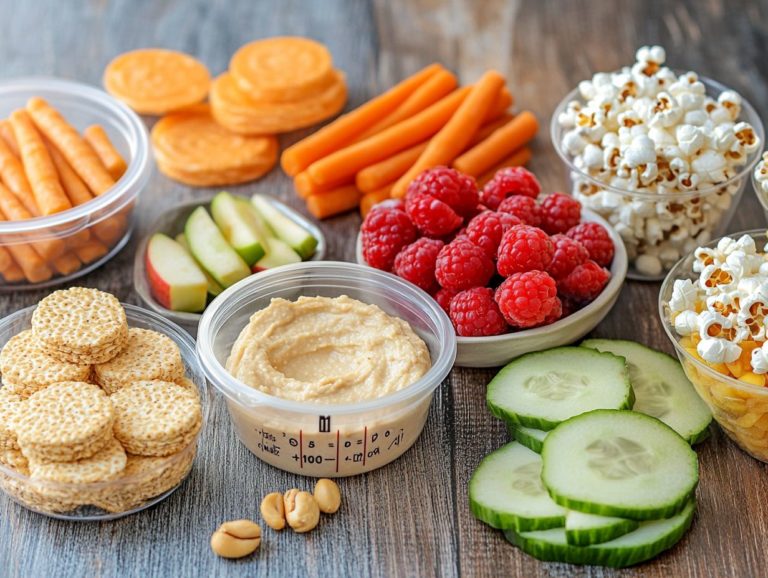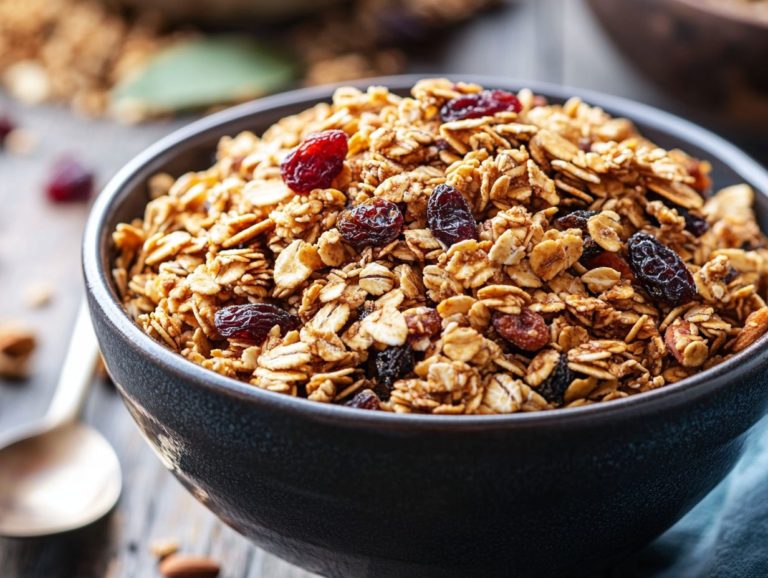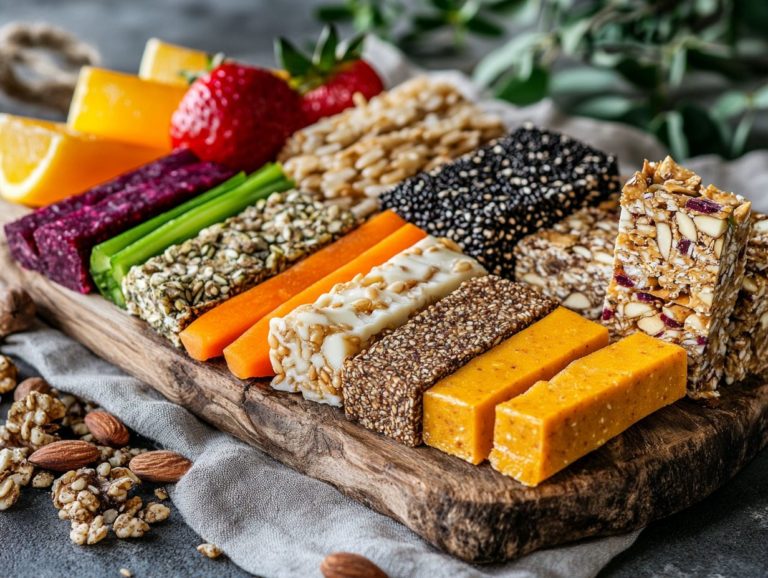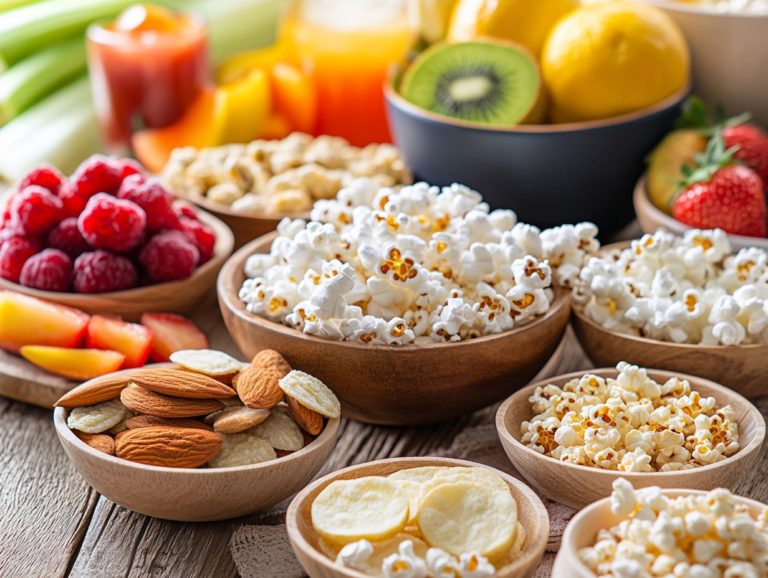Nut-Free Gluten-Free Snack Foods: What to Avoid
Navigating the snack landscape can be quite the adventure, especially for those with nut and gluten sensitivities. Finding safe, delicious treats that align with these dietary needs is crucial for both health and enjoyment in your snacking experience.
You can find a variety of options available, from fresh fruits and vibrant vegetables to crunchy rice cakes, all nut-free and gluten-free, without skimping on flavor.
Get ready to discover the tastiest nut-free, gluten-free snacks that will leave you craving more! This article highlights the ingredients you should steer clear of, and offers tips for selecting safe snacks, ensuring your satisfaction and peace of mind as you indulge.
Contents
- Key Takeaways:
- What are Nut-Free Gluten-Free Snack Foods?
- Why is it Important to Avoid Nuts and Gluten in Snacks?
- What are Some Common Nut-Free Gluten-Free Snack Options?
- What are Some Ingredients to Look Out for in Snacks?
- 1. Tree Nuts
- 2. Peanuts
- 3. Wheat and Other Gluten-Containing Grains
- 4. Cross-Contamination
- How to Read Labels for Nut and Gluten-Free Snacks
- What are Some Tips for Finding Nut-Free Gluten-Free Snacks?
- 1. Check for Nut and Gluten-Free Certifications
- 2. Read Ingredient Lists Carefully
- 3. Shop at Specialty Stores
- 4. Make Your Own Snacks
- Frequently Asked Questions
- Can I eat any type of crackers if I have a nut allergy and follow a gluten-free diet?
- Are all types of energy bars safe for me to eat if I have a nut allergy and follow a gluten-free diet?
- Can I eat all types of granola if I have a nut allergy and follow a gluten-free diet?
- What type of dips or spreads should I avoid if I have a nut allergy and follow a gluten-free diet?
- Can I eat all types of popcorn if I have a nut allergy and follow a gluten-free diet?
- Are all types of dried fruit safe for me to eat if I have a nut allergy and follow a gluten-free diet?
Key Takeaways:
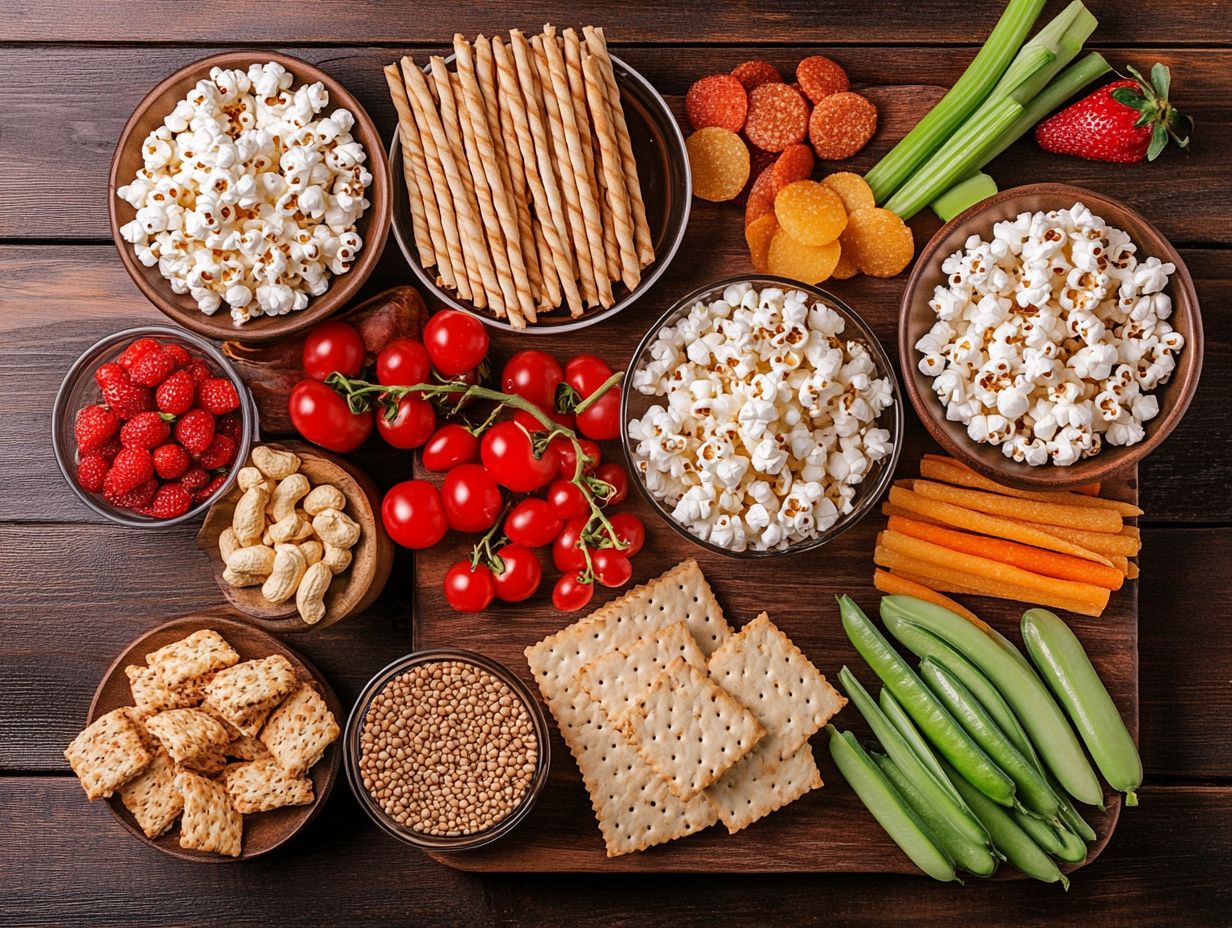
- Avoiding nuts and gluten in snacks is important for those with allergies or sensitivities to these ingredients.
- Some common nut-free gluten-free snack options include fruits and vegetables, rice cakes, popcorn, hummus and veggies, and gluten-free granola bars.
- When reading labels for nut and gluten-free snacks, look out for tree nuts, peanuts, wheat and other gluten-containing grains, and cross-contamination.
What are Nut-Free Gluten-Free Snack Foods?
Nut-free, gluten-free snack foods are essential for anyone navigating the challenges of gluten intolerance, celiac disease (an autoimmune disorder where the ingestion of gluten leads to damage in the small intestine), or various food allergies. These snacks offer a safe and delightful way for you to indulge your sweet tooth or savor savory treats without the worry of allergen exposure.
As this segment of the food market continues to grow, you’ll discover an array of nut-free, gluten-free options that feature diverse flavor combinations and wholesome ingredients, appealing to both children and adults alike. Whether you re in search of protein-rich alternatives or convenient meals, gaining an understanding of these snack foods can truly elevate your snacking experience.
Why is it Important to Avoid Nuts and Gluten in Snacks?
Avoiding nuts and gluten in your snacks is crucial if you have gluten intolerance, celiac disease, or serious food allergies. Consuming snacks with these ingredients can lead to severe health issues and gastrointestinal distress.
Healthcare providers often recommend a strict gluten-free diet to prevent reactions associated with gluten-related disorders. By understanding the importance of steering clear of these allergens, you can make safer snack choices that enhance your overall well-being.
For those managing these conditions, every bite matters; even trace amounts of gluten or nuts can trigger discomfort such as bloating, abdominal pain, or skin rashes. Nutritional education is essential in navigating these dietary restrictions, equipping you with the skills to read food labels effectively and identify safe options.
Healthcare providers might suggest alternative snacks that are both nutritious and free from these harmful substances, highlighting the advantages of a personalized dietary plan. This tailored approach minimizes health risks while allowing you to enjoy delicious food.
Ultimately, adhering to these dietary requirements can significantly enhance your quality of life and promote long-term health stability.
What are Some Common Nut-Free Gluten-Free Snack Options?
You ll find a wealth of delightful nut-free, gluten-free snack options that cater to a variety of tastes and dietary preferences. These snacks not only prioritize allergy-friendly ingredients but also embrace wholesome components that contribute to your overall health and well-being.
Consider indulging in gluten-free granola bars crafted with natural flavors and whole food ingredients, or coconut-based cookies sweetened with coconut sugar. There are also crispy chips made from grain-free alternatives that add a satisfying crunch.
Whether you re looking for something to satisfy a sweet craving or a nutritious option for both kids and adults, these snack ideas deliver a flavorful punch.
Explore these delightful snack options and consult with healthcare providers to find what works best for your dietary needs!
1. Fruits and Vegetables
Fruits and vegetables stand out as the easiest and healthiest nut-free, gluten-free snack options. They present fresh produce that is naturally devoid of gluten and allergens. This offers a delightful array of flavors, textures, and health benefits, making them suitable for everyone, including kids.
Incorporate healthy fats like avocado or hummus to enhance flavor. With a little creativity, you can prepare these snacks to entice even the pickiest of eaters.
Imagine crunchy carrot sticks paired with a zesty dip. Or sweet apple slices drizzled with almond butter the possibilities are truly endless!
Colorful bell peppers not only bring vibrant hues to your plate but are also brimming with vitamins A and C. These vitamins are essential for a robust immune system. If you re looking for a refreshing choice, cucumber slices or radishes offer hydration and a delightful crunch.
For something heartier, consider roasted sweet potato wedges or baked kale chips. They provide a flavorful alternative that is both nutritious and simple to whip up. These snacks not only nourish the body. They inspire creative culinary exploration and foster a lifelong appreciation for healthy eating habits.
2. Rice Cakes
Rice cakes present a popular gluten-free option, acting as a versatile canvas for a variety of toppings. This makes for a delightful nut-free snack. These crispy delights come in various flavors and can be enjoyed either sweet or savory, catering to a wide spectrum of taste preferences.
Customize rice cakes with natural flavors, such as peanut butter alternatives or fresh produce. This will create a satisfying snack that aligns with your gluten-free lifestyle.
The selection of rice cakes available is remarkable, ranging from traditional plain and light brown rice cakes to those infused with enticing flavors like caramel, sea salt, or even spicy chili. Each variety offers a unique taste profile, ensuring that there s something to satisfy different dietary needs and cravings.
A plain rice cake serves as an excellent backdrop for toppings like hummus and sliced cucumbers. Meanwhile, a sweet caramel option pairs beautifully with yogurt or fresh fruits.
Incorporating toppings such as seeds, herbs, or a drizzle of honey not only elevates the flavor but also enhances the nutritional value. This delightful blend of tastes and textures makes each bite an unforgettable experience.
3. Popcorn
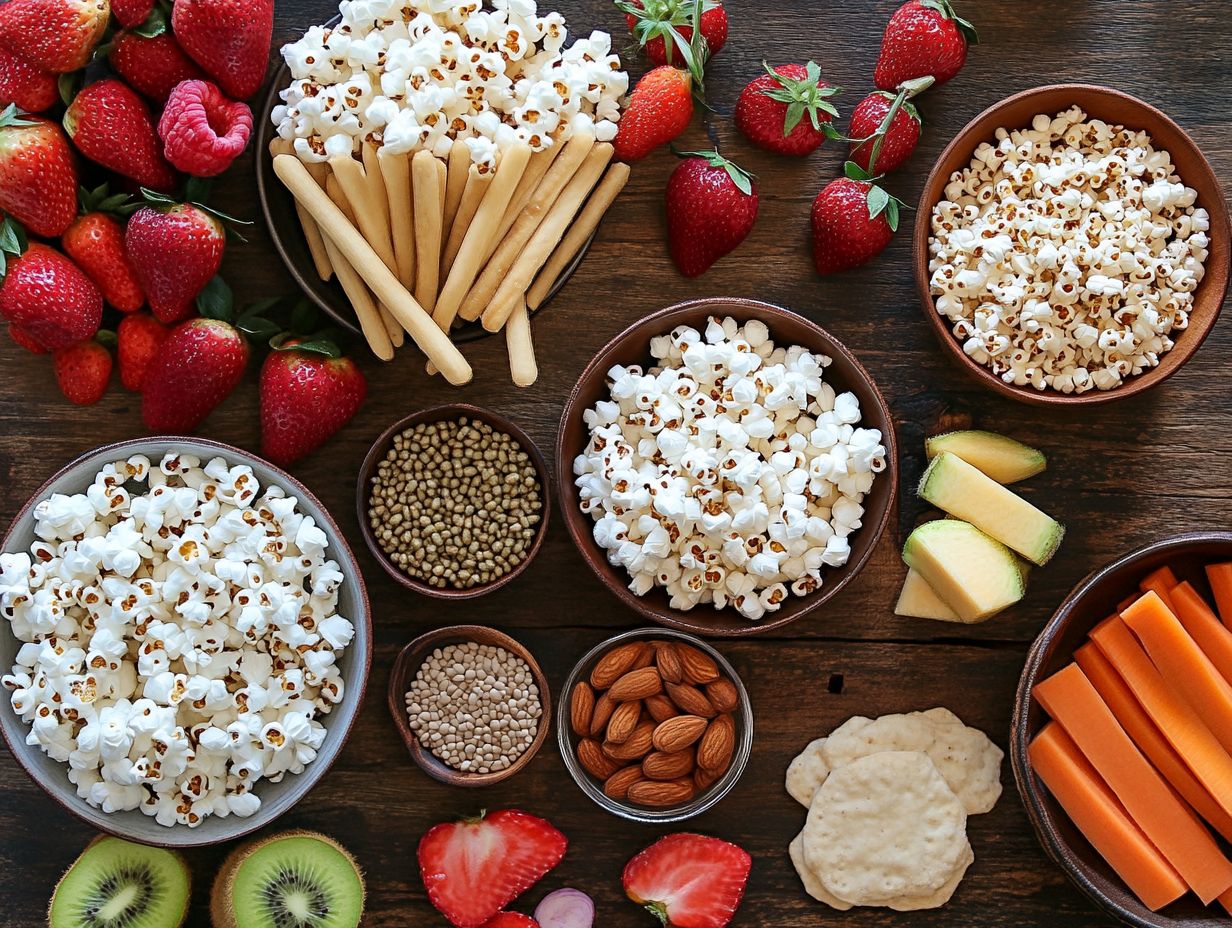
Popcorn stands out as an exceptional choice for a nut-free, gluten-free snack, celebrated for its satisfying crunch and delightful burst of flavor. With just a few simple ingredients, it easily adapts to various dietary preferences, making it a versatile meal option.
Elevate your popcorn experience and discover exciting new flavors! Experiment with an array of spices and toppings, unlocking endless flavor combinations while keeping it gluten-free and allergy-friendly.
Opt for air-popped popcorn for a light and airy treat or cook it in healthy oils like olive or coconut for a touch of richness. You ll discover that popcorn is both nutritious and convenient.
Its whole grain nature is packed with fiber, supporting your digestive health and helping you feel fuller for longer.
Regarding unique flavor inspirations, the possibilities are vast. From savory delights like nutritional yeast and garlic powder to sweet variations featuring cinnamon and cocoa, there’s a perfect popcorn recipe for everyone.
The minimal ingredients needed for preparation not only simplify the process but also encourage your creativity in the kitchen. Try out these flavors today and transform your snack time into a gourmet experience!
4. Hummus and Veggies
Hummus paired with fresh vegetables is not just a snack; it’s a delightful and nutritious experience that caters to your desire for something nut-free and gluten-free. This combination satisfies your hunger while providing healthy fats and proteins that contribute to your overall well-being.
The array of fresh produce available for dipping makes this snack a versatile choice, perfect for both kids and adults with a wide range of flavor preferences.
Incorporating vibrant vegetables like bell peppers, carrots, cucumbers, and cherry tomatoes can significantly elevate the health benefits of your snack. Each of these veggies adds a satisfying crunch and a burst of color while delivering essential vitamins and antioxidants that help bolster your immune system.
For a delightful twist, consider roasting some zucchini or eggplant and pairing them with a smoky hummus variant for a deeper flavor experience. Whether you re enjoying this nutritious duo in a casual setting or serving it as party appetizers, it meets various dietary needs, appealing to vegans, vegetarians, and anyone seeking healthier snack alternatives.
Next time hunger strikes, grab this delicious snack and enjoy every bite guilt-free!
5. Gluten-Free Granola Bars
Gluten-free granola bars are the perfect blend of convenience and taste, making them an ideal nut-free snack that seamlessly fits into any diet. Crafted with whole food ingredients and often packed with protein-rich options, these bars deliver sustained energy for both kids and adults on the move.
You ll find a delightful variety of flavors among many brands, ensuring a family-friendly selection that caters to diverse tastes and preferences. For those following a gluten-free diet, these granola bars are a fantastic choice.
Whether your preference leans towards classic chocolate chip or fruity concoctions like berry bliss, there’s a gluten-free granola bar to satisfy your cravings. Well-known brands, committed to quality, often enrich their bars with superfoods (nutrient-rich foods that provide health benefits) like chia seeds and coconut, boosting their nutritional value.
As a parent, you ll appreciate the simplicity of tossing a few bars into lunchboxes, while athletes will relish the quick energy boost they provide before workouts. With benefits that include high fiber content, healthy fats, and essential vitamins and minerals, these bars support a balanced, healthy lifestyle and do more than just quell your hunger.
What are Some Ingredients to Look Out for in Snacks?
When selecting snacks, it s essential to pay close attention to certain ingredients that could pose risks if you have food allergies, gluten intolerance, or other food sensitivities. Taking the time to read the ingredient list thoroughly can help you identify allergens and ensure that the snack is safe for your consumption.
Be particularly vigilant about key ingredients such as tree nuts, peanuts, and wheat, as well as any potential sources of cross-contamination. This diligence is vital for making informed dietary choices that align with your health needs, especially if you have gluten intolerance or food allergies.
1. Tree Nuts
Tree nuts rank among the most common allergens, often spotlighted on ingredient lists due to their potential to provoke severe reactions in those who are vulnerable. If you have food allergies or gluten intolerance, even the slightest trace of tree nuts can result in adverse health effects.
It s essential to grasp the risks associated with tree nuts to make informed snack choices and avoid cross-contamination. Opting for allergy-friendly snacks can be part of this strategy.
The implications of these allergies go beyond immediate physical reactions. You might experience symptoms such as hives, swelling, or gastrointestinal distress.
In more serious cases, exposure can trigger anaphylaxis a severe allergic reaction that can be life-threatening. Seek medical help right away if you experience severe symptoms!
Consulting with healthcare providers can help manage these risks effectively.
Cross-contamination is a considerable concern in both home and food service settings, where equipment and surfaces may conceal microscopic traces of tree nuts. It is crucial for individuals with tree nut allergies to get into the habit of reading labels.
For an additional layer of safety, consider choosing certified gluten-free products. This proactive approach not only ensures informed choices but also fosters safer eating experiences, ultimately contributing to your overall health and well-being.
2. Peanuts
Peanuts are a well-known allergen that can pose serious risks for those with food allergies and gluten intolerance. Often lurking in the ingredient lists of many processed snacks, peanuts can trigger severe allergic reactions, making it imperative for you to remain vigilant in steering clear of products that contain them.
By understanding the health claims associated with peanuts and their nutritional profile, you can make more informed choices and select safer snack alternatives.
The risks associated with peanut allergies can present themselves in a variety of symptoms, ranging from mild reactions like hives and itchiness to more dire cases of anaphylaxis, which can be life-threatening.
Therefore, it is essential for you to read labels carefully, as peanuts might be disguised under names such as groundnuts or arachis oil.
Try delicious substitutes like sunflower seeds or soy nuts they offer a crunchy treat without the risks! Keeping allergen information updated and sharing it with friends or caregivers is another smart move; it fosters a safer environment, especially in social situations where food-sharing is common.
3. Wheat and Other Gluten-Containing Grains
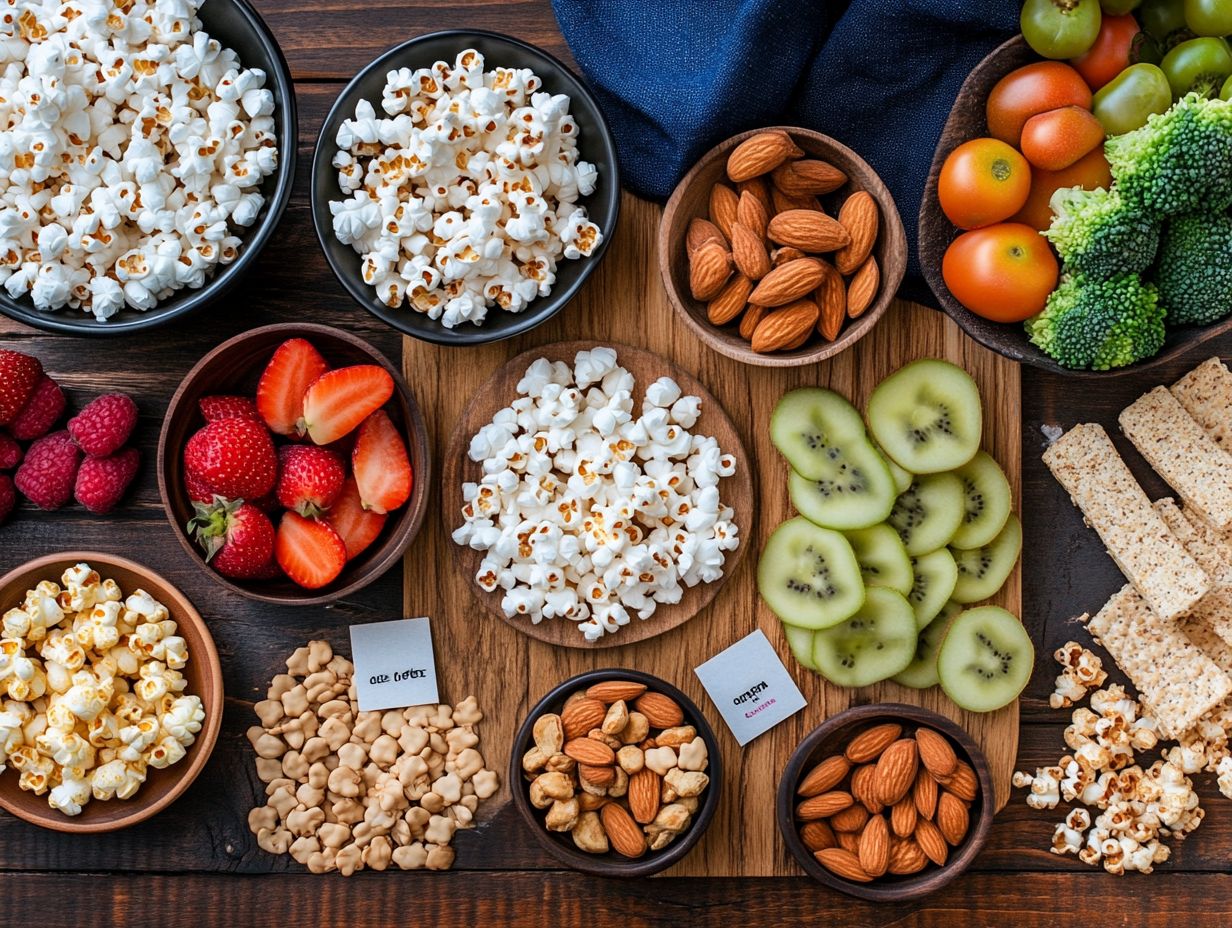
Wheat and other gluten-containing grains are paramount concerns for anyone dealing with gluten intolerance or celiac disease. It s essential for you to seek out gluten-free options in your snacks.
These grains can sneak into many processed foods, so taking the time to read ingredient lists meticulously is crucial to avoid accidental ingestion. By understanding the distinctions between gluten-containing and gluten-free grains, you enable yourself to make safer choices.
If you’re navigating the complexities of gluten-related disorders, developing a habit of scrutinizing labels is vital, as gluten can often hide in unexpected places.
Foods like sauces, dressing, and even certain dairy products might contain gluten as a thickening agent or flavor enhancer. Fortunately, the explosion of gluten-free alternatives has made it easier for you to find safe options for meals and snacks, ranging from quinoa and rice to an array of nut flours and legumes.
By becoming well-informed about these alternatives, you can elevate your diet while minimizing health risks, fostering a sense of independence and confidence in your nutritional choices.
4. Cross-Contamination
Cross-contamination can pose a significant risk if you have food allergies or gluten intolerance, leading to unintentional exposure to allergens. This often happens during food preparation or packaging, so it s essential to be vigilant when selecting snacks and to communicate with manufacturers or healthcare providers about their safety measures.
Understanding how to recognize and prevent cross-contamination is crucial for maintaining a safe diet.
You must be proactive in implementing best practices to mitigate these risks. This means using separate utensils and cutting boards for different food types. Thoroughly clean surfaces where allergenic foods are prepared and exercise caution with packaged food items that might not clearly disclose potential cross-contact (the unintentional transfer of allergens between foods) on their labels. Consulting with healthcare providers for the best strategies can also be beneficial.
Seeking certified gluten-free products and consulting with professionals who understand food allergies will enable you to navigate your dietary needs more effectively. Being aware and educated is vital, as it enables you to advocate for your health and ensure a safer eating experience.
How to Read Labels for Nut and Gluten-Free Snacks
Reading labels for nut and gluten-free snacks is crucial if you have food allergies or gluten intolerance your safety depends on it. By understanding how to interpret ingredient lists, you can identify potential allergens and hidden gluten-containing ingredients that might lurk in processed foods. Healthcare providers often encourage you to familiarize yourself with effective label reading; it s about enabling you to make safer snack choices.
This informal assessment can be a crucial skill for maintaining your health. By honing in on specific terms, you can easily understand the often confusing language found on packages. Keep an eye out for phrases like “may contain traces of nuts” or “processed in a facility that processes wheat”; these are definite red flags. Terms like “modified food starch” or “hydrolyzed vegetable protein” might also hint at the presence of gluten, even if they aren t labeled clearly.
Always look for dedicated allergen statements and certified gluten-free seals to ensure your safety! With a bit of practice, you can master the art of reading labels, making healthier and safer substitutions a seamless part of your daily diet.
What are Some Tips for Finding Nut-Free Gluten-Free Snacks?
Navigating the world of nut-free, gluten-free snacks can indeed be a daunting endeavor, but several strategies can streamline your search. For example, consider retail availability and explore various retail options to broaden your choices.
Start by seeking out products that clearly indicate they are nut-free and gluten-free, as this information is often highlighted in the ingredient list or on the packaging. Additionally, be mindful of gluten-free sweet snacks to avoid, as checking for simple ingredients can also help in identifying the best options.
Explore different retail options, including specialty stores and online marketplaces, to uncover a broader selection of allergy-friendly snacks that align with your health requirements. Numerous brands like Savor By Suzie, Artisan Tropic, Lil Bucks, Undercover Snacks, and Emmy s Organics offer excellent gluten-free options.
Stay informed and proactive to enjoy safer snacking!
1. Check for Nut and Gluten-Free Certifications
When you re on the hunt for nut-free gluten-free snacks, it s essential to seek out certifications that confirm these products are safe for your consumption. Many brands take pride in displaying nut-free and gluten-free labels, offering you the reassurance and clarity you deserve.
Consulting with health care providers can direct you toward reputable brands and products that meet these vital dietary requirements. Brands like Real Cookies, Choomies, Michele s Granola, Purely Elizabeth, XoChitl, and Siete are known for their reliable gluten-free products.
Keep an eye out for certifications from trusted organizations like the Gluten-Free Certification Organization (GFCO) and the International Nut and Seed Allergy Association (INSAA). These organizations are recognized for their rigorous standards, ensuring that the snacks you choose adhere to strict testing and manufacturing protocols, effectively minimizing the risk of cross-contamination.
Additional brands like Clio, Foods Alive, Cretors, Popcorners, Skinny Pop, and This Saves Lives Bars also provide excellent gluten-free snack options.
As you explore your options, take the time to read ingredient lists and look for any allergen warnings. Making informed choices can greatly affect your ability to avoid potential health risks, including gluten-related disorders.
Ultimately, by prioritizing these certifications, you can enjoy your snacks with complete confidence and peace of mind!
2. Read Ingredient Lists Carefully
Carefully reading ingredient lists is an essential step in your quest for nut-free, gluten-free snacks. This practice helps you identify potential allergens and gluten-containing ingredients, ensuring that what you choose aligns perfectly with your dietary requirements and food sensitivities.
Be aware of both common and hidden allergens in products. Understanding the health claims made by brands can shed light on the nutritional value and safety of the snacks you consider.
Reading honest reviews can also provide valuable insights. Being vigilant about the terminology used in food labeling is crucial; phrases like “may contain traces of” or “processed in a facility that handles nuts” are red flags signaling potential cross-contamination risks.
Familiarizing yourself with less common ingredients that might indicate the presence of gluten or nuts such as certain emulsifiers or flavorings can enhance your health safety, especially for individuals with celiac disease or gluten intolerance. Transparency in food labeling not only enables you to make informed choices but also encourages food manufacturers to uphold high standards of safety and honesty in their product formulations.
By diligently examining ingredient lists, you can navigate your dietary landscape with confidence and assurance, ensuring your choices align with your dietary requirements.
3. Shop at Specialty Stores
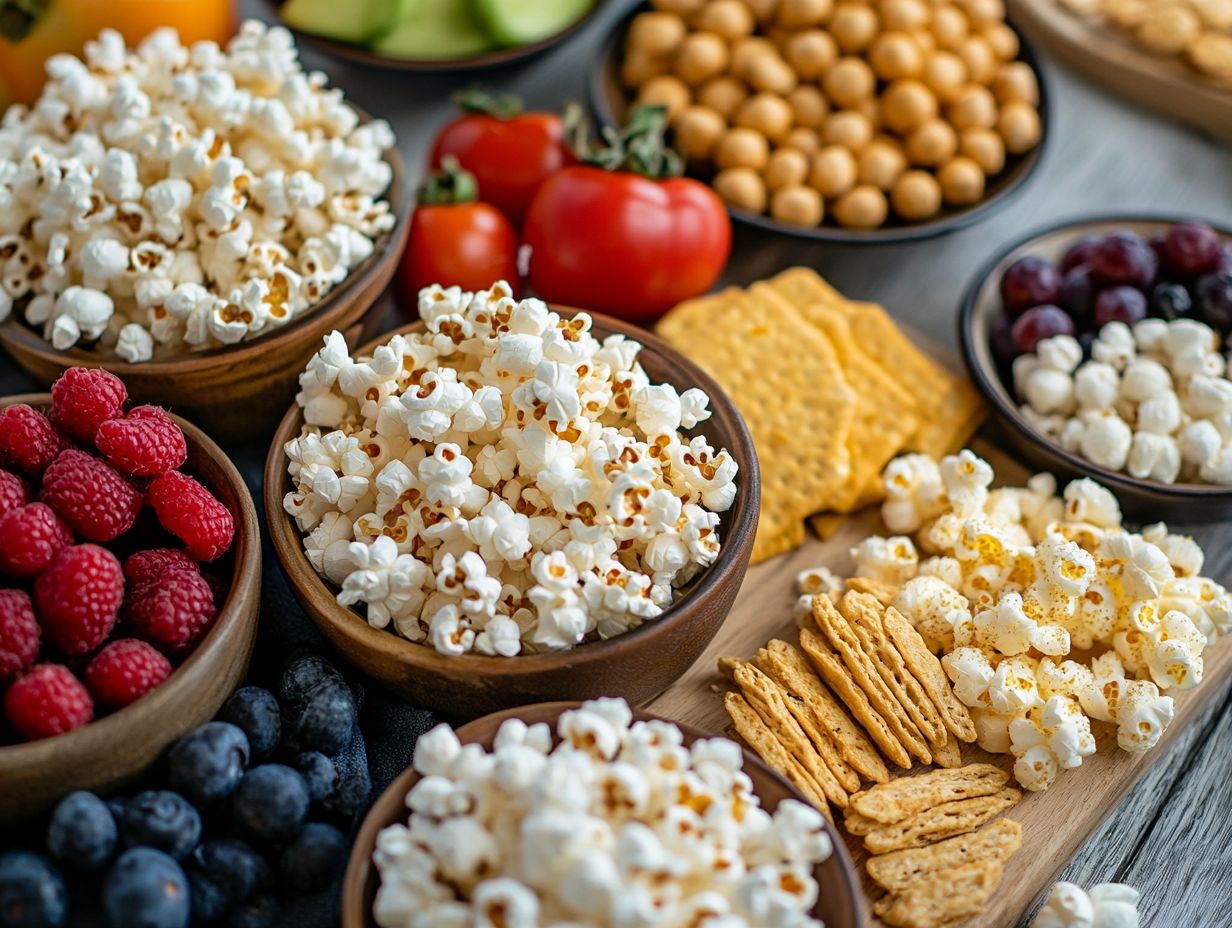
Shopping at specialty stores is often your best bet for discovering a diverse selection of nut-free, gluten-free snacks. These establishments cater specifically to individuals with food allergies, gluten intolerance, and other food intolerances, providing a variety of gluten-free options that you just won t find in conventional supermarkets.
Consulting with your health care provider can also help you identify local specialty stores that are renowned for their quality selections. As you explore these curated shops, you’ll likely notice that they prioritize high-quality ingredients and unique flavors, creating a delightful experience for anyone with dietary restrictions.
Finding these gems can be as easy as a quick online search or scrolling through social media platforms, where many of these stores showcase their delectable offerings, including gluten-free products from brands like Savor By Suzie, Artisan Tropic, and Lil Bucks.
When you step inside, prepare to be pleasantly surprised by the wider assortment of products available, including gluten-free options like crispy chips and vegan options. Plus, you can rely on knowledgeable staff who can offer personalized recommendations and guidance tailored to your specific dietary needs.
Start your journey to healthier snacking today!
4. Make Your Own Snacks
Making your own snacks is not just rewarding; it s a savvy way to ensure they are perfectly nut-free and gluten-free. By using simple ingredients like quinoa flakes, coconut sugar, and healthy fats, you can create delicious treats that cater to your unique taste preferences and dietary needs.
This approach gives you control over ingredient selection, allowing you to make a variety of healthy snacks and snack ideas that truly satisfy your cravings.
Incorporating an array of flavors and textures think dried fruits, seeds, and a mix of spices can elevate your creations and appeal to diverse palates. For example, imagine the delightful crunch of toasted pumpkin seeds tossed with cocoa powder and a hint of sea salt; it s a snack that can truly tantalize your taste buds.
Experimenting with different sweeteners like maple syrup or agave nectar can add an intriguing twist, ensuring that each batch is uniquely yours and satisfies your sweet craving.
The possibilities are endless, and with a touch of creativity, these personalized snacks can easily become favorites for everyone in the family. Consider making family-friendly options such as gluten-free granola or coconut-based cookies to accommodate various preferences.
Frequently Asked Questions
Can I eat any type of crackers if I have a nut allergy and follow a gluten-free diet?
No, there are certain types of crackers that contain nuts and gluten, such as some multigrain or flavored varieties. It’s important to always check the ingredients list before consuming any type of cracker. For gluten-free options, look for brands like Real Cookies or Choomies.
Are all types of energy bars safe for me to eat if I have a nut allergy and follow a gluten-free diet?
No, many energy bars contain nuts or are processed in facilities that also handle nuts. Look for energy bars that specifically state they are nut-free and gluten-free. Brands like Undercover Snacks and Michele s Granola offer allergy-friendly snacks that could be suitable for you.
Can I eat all types of granola if I have a nut allergy and follow a gluten-free diet?
No, some granola can contain nuts and gluten, such as almond granola or granola made with wheat-based ingredients. Always check the ingredients list to ensure it’s safe for you to consume. Brands like Purely Elizabeth and XoChitl offer gluten-free granola options.
What type of dips or spreads should I avoid if I have a nut allergy and follow a gluten-free diet?
You should avoid any dips or spreads that contain nuts or are made in facilities that also handle nuts. This includes popular dips like hummus, which can sometimes contain tahini (a paste made from sesame seeds), and spreads like almond butter. Try looking for gluten-free options that are clearly labeled as nut-free and gluten-free.
Can I eat all types of popcorn if I have a nut allergy and follow a gluten-free diet?
No, some types of popcorn may contain nuts or be processed on equipment that also processes nuts. Choose delicious, plain air-popped varieties or those specifically labeled as nut-free and gluten-free for a safe snack!
Brands like Popcorners and Skinny Pop provide tasty gluten-free snacks.
Are all types of dried fruit safe for me to eat if I have a nut allergy and follow a gluten-free diet?
No, some dried fruits, such as cranberries or cherries, may be processed on equipment that also handles nuts. Always check the label to ensure it’s a safe option for you.
Brands like DeeBees Organics and Go Go Squeeze offer great gluten-free products.

